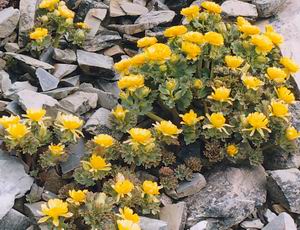Ranunculus acraeus facts for kids
Quick facts for kids Ranunculus acraeus |
|
|---|---|
 |
|
| Scientific classification | |
| Genus: |
Ranunculus
|
| Species: |
acraeus
|
The Ranunculus acraeus, also called the Alpine buttercup, is a beautiful flowering plant. It belongs to the buttercup family, called Ranunculaceae. You can find this special plant only in New Zealand.
This rare plant grows strictly in alpine areas, which are high up in the mountains. That's why it's called acraeus, meaning "on high". The plant can spread about 50 cm (20 in) wide. It has bright, cheerful yellow flowers. Sometimes, people might confuse it with another plant called R. piliferus. However, scientists have studied it and confirmed that R. acraeus is its own unique species.
Contents
How the Alpine Buttercup Was Found
The R. acraeus was first seen way back in 1940. But at that time, people thought it was just a type of R. haastii.
Then, in 1998, a gardener was hiking on Mount St. Mary in North Otago. They spotted the plant and decided to take it to a plant expert, called a botanist. The botanist carefully checked the plant and confirmed it was a brand new species!
Where the Alpine Buttercup Lives
The R. acraeus is an endemic plant. This means it only grows in a very specific part of the world. You can find it only on the South Island of New Zealand, in the North Otago region.
More specifically, it lives in places like the Barrier Range, St Marys Range, St Bathans Range, Kakanui Mountains, Ida Range, and the Waitaki Valley. It also grows in the Hall Range and Godley River valley in southwest Canterbury.
These buttercups live in small groups spread out across these areas. The biggest group found has about 200 plants. This large group is on Mount St. Mary in the St. Mary's Range. The smallest groups have only three or four plants. These tiny groups are found on mountains near the Ohau skifield and close to Tekapo.
Sadly, the R. acraeus is considered "nationally critical" and "acutely threatened." This means it's in great danger. Some threats come from animals that were brought to New Zealand, like chamois, hares, and thar. Even Domestic sheep grazing in the high mountains during summer can be a problem for these buttercups. These animals also threaten other special alpine plants.
Home and Environment of the Alpine Buttercup
The R. acraeus loves high mountain environments. It grows in rocky areas where the rocks are stable and coarse. These rocks are called schist and greywacke. They are broken into rough, angular pieces of different sizes, usually about 10–30 cm across.
You can find these plants on rocky mountain slopes that are at least 1500 meters high. These buttercups do not do well in lower areas. If they are moved to lower altitudes, they will die.
What the Alpine Buttercup Looks Like
The R. acraeus can be confused with R. piliferus. However, there are tiny differences in their shape that make them separate species.
The R. acraeus has leaves with finely wavy edges. Its flower stems are smooth and glossy, without hairs. These plants usually have 6 to 7 sepals. Sepals are like small leaves that protect the flower bud. The top side of the sepals is smooth, while the bottom side is hairy. The hairs on the bottom are fine and soft. The top side is smooth, especially near the base. Each stem holds one flower. These features help tell it apart from R. piliferus, which has hairy sepals on both sides.
This plant is strong and grows new shoots each summer. It has many thick, fleshy underground stems called rhizomes. These rhizomes are about 10–12 mm wide and have many long, fleshy roots. The roots are 2–5 mm wide.
The plant forms large, thick clumps that can be up to 1 meter wide, or even bigger! The shoots can grow up to 40 cm tall. The hairs on the R. acraeus are weak, soft, thin, and spread out.
The leaf stalks, called petioles, are 5–25 cm long and 5–9 mm wide. The flower stalks, called scapes, are 8–40 cm long and 5–14 mm wide. They are green or yellowish-green, and sometimes have a reddish color near their base.
Flowers and Fruits of the Alpine Buttercup
The R. acraeus has amazing yellow flowers that are 4–5 cm wide. Some flowers might even be green. Each flower has a leafy bract underneath it. There are 6 to 7 sepals, which are yellowish-green to light-green. The plant has a simple pit that produces nectar, which attracts pollinators.
The Alpine buttercup flowers between November and January. It produces fruits between December and January.
Uses of the Alpine Buttercup
There are no known uses for the R. acraeus. These plants cannot survive if they are taken out of their high mountain homes. They would make a wonderful ornamental plant, meaning a plant grown for its beauty, if only they could live in other places.
Images for kids
See also
 In Spanish: Ranunculus acraeus para niños
In Spanish: Ranunculus acraeus para niños


